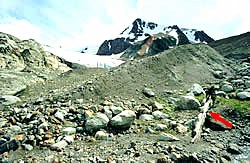Tree stumps at the foot of glaciers in western Canada show that glaciation there is at a 7000-year low. The revelations could provide new insights into the accelerated rates at which these ancient rivers of ice are shrinking because of climate change.
Geologist Johannes Koch of The College of Wooster and colleagues have found deceptively fresh and intact tree stumps beside the retreating glaciers of Garibaldi Provincial Park, which lies about 60 km north of Vancouver, British Columbia. What puzzled Koch most about these stumps was just how long ago the glaciers entombed this forest in ice. Fortunately, he had access to sophisticated radiocarbon dating technology and determined that the trees first entered the big freeze a staggering 7000 years ago.

Dr. Johannes Koch
The stumps were in very good condition sometimes with bark preserved, explains Koch, who presented the results at the Geological Society of America Annual Meeting in Denver on October 31. Their pristine condition could best be explained if the stumps had spent many millennia trapped under dozens of metres of ice. Astoundingly, all the stumps were still rooted to their original soil and location.
These stumps really indicate when the glaciers overrode them, and their kill date gives the age of the glacier advance, Koch adds. They also give us a span of time during which the glaciers have always been larger than they were 7000 years ago, until recent warming released the stumps from their icy tombs.

Overlord Glacier is 7000 years old (Photo courtesy of Johannes Koch)
If that were the only evidence, then the story of Koch’s stumps would not be quite so significant. However, he also compared the kill dates of the trees in the southern and northern Coast Mountains of British Columbia and those in the mid- and southern Rocky Mountains in Canada to similar records from the Yukon Territory, the European Alps, New Zealand and South America, as well as to the age of Oetzi, the prehistoric mummified alpine Iceman found at Niederjoch Glacier, and similarly well-preserved wood from glaciers and snowfields in Scandinavia. The radiocarbon dates seem to be the same around the world.
It’s important to note that there have been many advances and retreats of these glaciers over the past 7000 years, but no retreat has pushed the glaciers back so far upstream as to expose these trees. The age of the tree stumps gives new emphasis to the well-documented before and after photographs of retreating glaciers during the 20th century. It seems like an unprecedented change in a short amount of time, Koch adds, From this work and many other studies looking at forcings of the climate system, one has to turn away from natural ones alone to explain this dramatic change of the past 150 years.
Further reading
Alpine Glaciers in Western Canada approach their smallest size of the past 7000 years
http://gsa.confex.com/gsa/2007AM/finalprogram/abstract_127930.htm
Suggested searches
glaciers
global warming
climate change